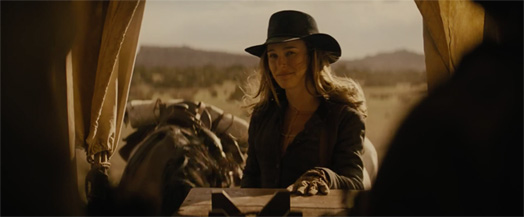|
|
Movie Review: Jane Got a GunBy Ben GruchowFebruary 10, 2016
A relatively clean storyline, all told, and yet Jane Got a Gun hopscotches through its past and present so haphazardly that it’s all but impossible in the early going to attach much meaning to any one scene. Example: Jane’s first meeting with John is shown in flashback, in rather spurious fashion. Jane just happens to recollect the scene while looking at a Wanted poster in a general store, and since we already know who John is and what he represents, the timing of this unveiling seems to happen because the editor needed a way to transition from Jane riding into town to Dan’s rather violent introduction into the main storyline. Even when the editing isn’t betraying the rhythm and flow, a considerable amount of the story unfolds in fits and starts, with neither Portman nor her co-stars able to lock down exactly where they’re supposed to be approaching a particular scene from. There is a crucial development about halfway through the movie, concerning Jane receiving some news about her young daughter. This moment feels like it should be something fairly easy to hit the audience with; Portman is absurdly talented at communicating subtle shades of conflicting emotion, and the setup and scenario are effectively done. And yet, something doesn’t click: some combination of the framing, the timing, and Portman’s invocation of her character’s motivation in that moment feels off. The movie does eventually lock into a decided rhythm and tone somewhere around the beginning of the third act, and there are more scenes than not where director Gavin O’Connor and editor Alan Cody seem to get a handle on where the story should be going. In particular, three scenes come to life and just about thrum with quiet tension: the first, unfortunately, involves Jane more as a catalyst to violence than an active participant in the scene…but until then, it’s a nicely done faceoff between Edgerton and one of the Bishop Boys, dependent on deception and poker face. The second and third scenes are the best of the group, and it comes down to nothing more than introspective conversation between Jane and Dan, while waiting for someone to approach; the two discuss their past and present and future in mature and effective terms, and we get a sense of the operatic Western that Jane Got a Gun could have been. The action, too, sticks the landing more often than not; I’ve already mentioned Walker’s photography, but credit must equally go to Tim Grimes and James Oberlander for their production design and Edward McLoughlin for his set decoration. These four individuals have created an environment that is not exactly grand or epic in most senses…but it feels real; the locations look like places the production crew found and carted a camera and the actors to, rather than places purpose-built. That’s a lot tougher to do with a period piece than it sounds, and especially tough to do in a little-represented genre like the Western, and it deserves mention. Much has been written about the movie’s tortured production history; in case another reminder is needed, the movie’s IMDb page provides a helpful listing of the cavalcade of producers drawn on during its making. I’m glad it saw the light of day, I guess, if only because there are disparate elements here that are worth seeing; it’s just a shame that the ambition on display and the evident effort to rescue the project resulted in something that’s so much less than the sum of its parts.
|

|
|
|

|
Thursday, October 31, 2024
© 2024 Box Office Prophets, a division of One Of Us, Inc.


